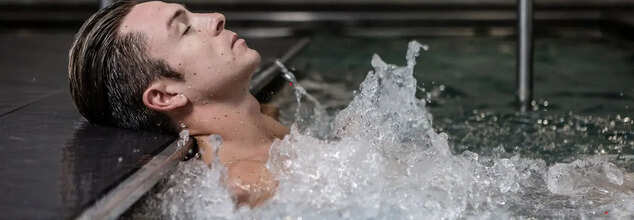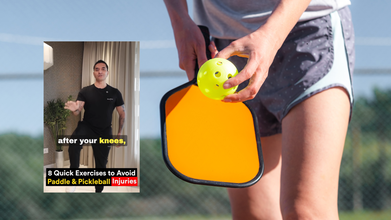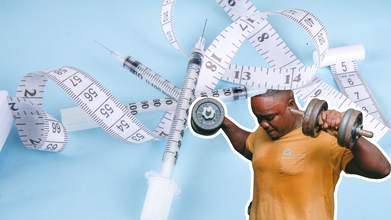- Health Conditions A-Z
- Health & Wellness
- Nutrition
- Fitness
- Health News
- Ayurveda
- Videos
- Medicine A-Z
- Parenting
- Web Stories
Should You Take Hot or Cold Water Soaks for Muscle Recovery?

Muscle Recovery (Credit: Canva)
Recent research has shed new light on the benefits of hot water soaks for recreational athletes, suggesting they may be more effective than cold water immersion for muscle recovery. This study, conducted by a team from Ritsumeikan University in Japan, found that soaking in hot water after a vigorous workout can help improve muscle efficiency and power output—especially for sports or workouts that involve breaks.
Why Should You Take Hot Showers?
When we exercise intensely, muscle fibers are inevitably damaged, leading to soreness and fatigue. Traditionally, ice baths have been touted as the go-to method for muscle recovery, as the cold helps reduce inflammation and relieve soreness. However, the new research indicates that hot water soaks can be more beneficial for enhancing muscle function and performance in certain situations.
According to Mamoru Tsuyuki, a master's student in sports and health science at Ritsumeikan University, heat can be particularly effective for athletes who need to perform multiple times in a day, such as in sports with halftime breaks. "When you need to perform twice in the same day, such as in sports that have a halftime, heat is better," Tsuyuki explains. "During the 15 or 20 minutes, if you can immerse yourself in hot water, you can probably perform better in the second half."
Heat works by increasing blood flow, which helps with muscle repair and recovery. By boosting muscle temperature, it also improves power output, enabling athletes to recover faster and perform more effectively in subsequent sessions.
Study Was Conducted on 10 Men
For the study, 10 young men participated in a three-part experiment. After performing 50 minutes of high-intensity interval running, the participants soaked for 20 minutes in either a 59-degree cold tub, a 104-degree hot tub, or did not immerse themselves in water at all. The researchers then measured their ability to jump, testing their vertical jump height both from a standing and squatting position one hour after the workout.
The results were telling: the men who soaked in hot water showed a higher jump height compared to those who soaked in cold water. There was no difference in muscle soreness between the hot and cold groups, which suggests that while hot water may help restore performance, it does not significantly impact muscle soreness levels.
Ice Baths: Still Valuable for Muscle Soreness
While hot water soaks may be more effective for power recovery and performance, icy soaks are not without merit. Cold water immersion has long been used to alleviate muscle soreness, particularly after endurance sports. Tsuyuki acknowledges that his study focused on high-intensity interval running, and that results may vary depending on the sport.
For those who prefer cold water, Dr Putrino, a health expert, explains that ice baths can be beneficial for injuries, but they may not be ideal immediately following an intense workout. Cold water constricts blood vessels, which can cause muscles to tighten and may hinder recovery after high-intensity exercises.
Recommendations for Soak Durations and Temperatures
Experts recommend the following for both hot and cold soaks:
- Hot Water Soak:
Soak for 10 to 20 minutes in water heated to 98 to 104 degrees Fahrenheit. This temperature range is ideal for improving blood circulation and muscle recovery.
- Ice Water Immersion:
For those seeking cold therapy, the optimal time is 10 to 15 minutes in water temperatures ranging from 50 to 59 degrees Fahrenheit. For first-timers, even a 5-minute cold soak can offer benefits without overstimulating the body.
Struggling with Irregular Periods? Try These 5 Yoga Poses to Regulate Your Menstrual Cycle

Credits: Canva
The fast-paced lives of women today, whether it’s school exams, college projects, work deadlines, or managing countless household chores can cause significant stress, leaving both the body and mind drained. Prolonged stress isn’t just exhausting, it can also affect physical health, mental well-being, and hormonal balance, which in turn can disrupt one of the key functions of the female body, which is the menstrual cycle.
Can Stress Disrupt Your Menstrual Cycle?
Medically known as menstruation, the menstrual cycle involves shedding the uterine lining (endometrium) through vaginal bleeding. Typically, cycles occur every 28 days, though slight variations are normal. However, gynecologists in India and across the globe are seeing an increasing number of women reporting irregular periods, a trend that is cause for concern.
Irregular cycles are generally defined as those occurring after gaps of more than 35 days or when the timing varies unpredictably each month. While irregular periods are common during teenage puberty or around menopause for women over 45, they can signal underlying issues in women in their twenties and thirties, requiring proper medical attention.
Other Factors That Can Lead To Irregular Menstrual Cycle
Beyond stress, other factors contributing to irregular periods include sudden weight changes, excessive exercise, emotional challenges, medication side effects, and chronic conditions like diabetes or hypertension. Timely medical care is essential because irregular cycles can sometimes indicate serious conditions, including polycystic ovarian syndrome (PCOS), endometriosis, or even cervical cancer. Symptoms often include heavy bleeding, spotting between periods, post-intercourse bleeding, menstrual bleeding in menopause, severe abdominal cramps, and extreme fatigue.
While medications and supplements can help balance hormones, Yoga, a centuries-old natural practice can complement medical treatment by promoting overall reproductive health and helping regulate menstrual cycles. Yoga combines stationary postures, stretching movements, and controlled breathing to reduce stress, relax the body, calm the mind, and support reproductive function. Below are some effective yoga poses to help regulate your cycle and enhance women’s health.
Yoga for Irregular Periods
Matsyasana (Fish Pose)
Lie flat on your back with arms under your hips, elbows close to the waist. Bend your legs into a cross-legged position with knees and thighs touching the floor. Inhale and gently lift your upper body and the back of your head, hold for a few breaths, then exhale and relax.
Dhanurasana (Bow Pose)
Lie face down with feet slightly apart and arms by your sides. Bend your legs and hold your ankles, lifting your chest and legs off the floor while inhaling. Hold as long as comfortable, then slowly lower back down.
Adho Mukha Svanasana (Downward-Facing Dog Pose)
Start on all fours, hands straight and head facing forward, knees bent, feet on the floor. Exhale and lift your hips, straightening your arms and forming a V-shape. Hold for a few breaths, then return to the starting position.
Malasana (Garland Pose)
Squat on the floor with heels flat, thighs wide, and feet close together. Exhale and fold forward, placing your torso between the thighs. Bring elbows to the inner thighs, applying gentle pressure, lift heels slightly, then return to a relaxed squat.
Ustrasana (Camel Pose)
Kneel with heels flat, hands on hips, keeping knees and shoulders aligned. Inhale and arch your back, holding your feet for balance. Stay for about a minute, then return slowly to upright. Alongside professional care, medications, and a healthy diet, daily yoga and meditation can help regulate menstrual cycles.
Stress, whether physical, mental, or emotional, can trigger irregular periods. Work pressure, household responsibilities, or personal challenges may create tension, anxiety, or panic, disrupting hormonal balance. Doctors advise women to step back from stressful situations, practice deep breathing, stay hydrated, and get enough sleep to restore calm and support healthy menstrual cycles.
8 Pickleball Warm-Up Exercises To Avoid Injuries, According To Expert

Credits: Canva and Instagram
Pickleball and padel, a sport that has gained momentum across India, is changing everyone's lives and helping people stay fit and active. However, while the game has gained many enthusiasts, fitness experts are also warning that enthusiasm without preparation can come at a cost. As many are reporting sports-related injuries, especially while playing pickleball. Luke Coutinho, lifestyle guru and holistic wellness expert in his Instagram video claims that he has seen a surge in knee, elbow, and lower back injuries linked to the sport.
“Pickle and paddle are two of the fastest-growing sports across our country right now, great for longevity, hand-eye coordination, and overall fitness,” says Coutinho. “But what’s equally important is knowing how to look after your knees, glutes, and elbows.”
Also Read: The Ozempic 'Trick' Could Cause More Harm For Non-Diabetic And Fit People, According To Doctors
According to him, just five minutes of targeted warm-up can dramatically lower the risk of injury. Here are the eight quick exercises Coutinho recommends before every game.
Wall Sit Toe Raises
You can start this exercise by leaning against a wall, sliding down until your thighs are parallel to the ground. Imagine as if you are sitting on an invisible chair. Keep your back as flat as you can against the wall. Coutinho says that this will "protect your knees and prevent shin splints."
How to do it:
- Hold this position and lift your toes upward while keeping your heels on the ground.
- Lower them back down slowly.
Why it helps: Strengthens the muscles in your shins and stabilizes the knees, helping prevent shin splints and knee strain.
Wall Sit Calf Raises
Coutinho suggests that you can follow up by this exercise. You can start from the same wall-sit position. This variation focuses on the calves and ankles.
How to do it:
- Keep your back flat against the wall, feet shoulder-width apart.
- Lift your heels up as high as possible, balancing on your toes.
- Slowly lower and repeat.
Why it helps: Builds ankle strength and lower leg stability, Coutinho suggests that it is the key for all those quick lateral pickleball movements.
Wall Knee Extensions
- Stay in the wall sit and extend one leg straight out in front of you.
- Hold for two seconds, then switch legs.
"It engages your quadriceps and enhances knee stability, reducing the risk of ligament tears," he points out.
Dynamic Lunges with Overhead Reach
While lunges are a great way to ensure mobility and flexibility, a little bit of modification could lead to a full-body stretch, along with balance training.
How to do it:
- Step forward into a lunge, keeping your front knee above your ankle.
- Raise both arms overhead as you lower your body.
- Push back to starting position and switch sides.
Why it helps: Opens your hips and chest while activating major leg muscles, prepping your core for rotational movements during play.
Mini Band Side Walks
How to do it:
- Place a resistance band just above your knees.
- Bend slightly at your hips and knees, then step sideways.
- Take 10 steps in one direction, then back.
Why it helps: Strengthens the glutes and prevents the knees from collapsing inward during sudden lateral shifts.
High Knees
This is probably the easiest, and one of the most common exercises anyone will encounter, especially while playing sports. It is a great way to warm up or cool down your body after a strenuous workout.
How to do it:
- Start by jogging in place, and bring your knees high, towards your chest.
Why it helps: It improves agility, coordination, and cardiovascular readiness before fast-paced rallies.
Knee Side Raises
How to do it:
- Stand upright, lift one knee out to the side, hold briefly, and lower it down.
- Repeat on the other side.
Why it helps: Builds lateral hip strength and enhances balance, crucial for sidesteps and quick turns.
Kickbacks
How to do it:
- Stand tall, kick one leg straight back without arching your back.
- Engage your glutes and hamstrings as you lift.
Why it helps: Activates the glutes and hamstrings, adding power to your movements and reducing lower back strain.
“Do 10 reps on each side, and you’re game-ready, explosive and injury-proof,” Coutinho says. “Looking after your health to prevent injury is the first step toward holistic wellness and longevity.” As he rightly says, "These warm-ups aren't optional, they are essential."
The Ozempic 'Trick' Could Cause More Harm For Non-Diabetic And Fit People, According To Doctors

Credits: Canva
Ever since fat loss jabs hit the market, including Ozempic, Mounjaro and Wegovy, gym enthusiasts and slim people are also turning to these popular weight loss drugs to enhance their physique. However, experts are sounding the alarm - they are warning that for those without obesity or diabetes, the risks outweigh the rewards.
The Rise of 'Fit' People Using Fat-burning Jabs
People who are already leading active lives are also reaching out for medications designed for obese people, especially those who want to crash diets before holidays, body builders and gym regulars. They have said that these drugs have helped them shed the "last few pounds" and sculpt leaner physiques easily.
The Sun reported that in bodybuilding, the phase of losing fat to highlight muscle definition is called "cutting". For some, GLP-1 drugs have become the shortcut to achieve that. However, UK's Medicines and Healthcare products Regulatory Agency (MHRA) has warned against using these jabs for the same.
Doctors have time and again cautioned against its use for non diabetic or obese persons, and highlighted side effects like nausea, fatigue, dehydration, and muscle loss.
Read: How To Identify A Counterfeit Ozempic? Look For These Signs, Details Inside
It Is Not A Shortcut
Dr Amos Ogunkoya, GP and sports medicine specialist, says and is as reported by The Sun, “Using weight-loss jabs when you already have low body fat is not a good idea. These medications slow digestion and suppress appetite, which can quickly lead to dehydration, fatigue, or even muscle loss in people with low energy reserves.”
He adds that extreme calorie restriction combined with low fat stores may trigger hormonal imbalances, depression, and anxiety. “In short, it’s not a shortcut, it’s a risk,” he warns.
Experts are also worried about the trend, which may have a log lasting impact on vulnerable people, especially those living with eating disorder. Dr Donald Grant, Senior Clinical Advisor at The Independent Pharmacy, as reported by The Sun, says many fitness enthusiasts are mixing GLP-1 drugs with performance-enhancing substances and restrictive diets, a combination with unknown risks.
“These medications were never designed for lean athletes and haven’t been studied in this group,” he says. “The long-term side effects in this population remain largely unknown.”
So, Why Are Fitness Buffs Doing It?
For some, it is about control. Wegovy (semaglutide) and Mounjaro (tirzepatide) are part of the GLP-1 receptor agonist family that help people with diabetes manage blood sugar by suppressing appetite and slowing stomach emptying. This side effect can make even the most disciplined eaters feel perpetually full.
Competitive bodybuilder Dr Michael Israetel, who holds a PhD in Sports Science, told Sun Health: “I wouldn’t diet without it. It helped me stay lean with less hunger and better sleep, same results, but in less time and with far less stress.”
He described how even small meals became a challenge: “I’d start eating already half-full. After a few protein bars, I was just done, no cravings. It was a total game-changer.”
Read More: Ozempic Soon To Be Launched In India, Here's All That You Should Know About This Weight Loss Drug
Micro-dosing Weight-loss Drugs
Some clinics are now offering microdosing of these popular weight loss drugs to be given in smaller doses than standard prescription for those who want to attain that 'little bit more' to be fit.
Dr Omar Babar, from Headland Clinic in Leicester tells The Sun, “Microdosing is very useful for gym goers. It cuts out food noise and has a low side-effect profile.”
Most weight-loss patients start at 2.5 mg doses that increase gradually, but many fitness users start as low as 0.25 mg. Experts, however, strongly caution against adjusting doses without medical supervision.
While in theory the access of drugs are tightly controlled, as the NHS recommends only those with a BMI 30 or higher and at least one health condition to receive it. Privately, the threshold is much lower, with some clinics being accused of exploiting loopholes that makes it easy for anyone to qualify to get those jabs.
Dr Grant says, “The biggest concern is people obtaining the medication illegally, via black-market sites, social media sellers, or using someone else’s prescription. Without GP supervision, dosing can become inconsistent and extremely dangerous.”
What Are The Side Effects Of Fat Loss Jabs On Healthy People
- Muscle Loss: Muscle loss could be one of the biggest risk. Dr Ogunkoa suggests that "muscle wastage is dangerous. It reduces strength, endurance, and overall metabolism. If you have got little fat to lose, your body will start consuming muscle instead."
Athletes using these jabs risk developing Relative Energy Deficiency (RED), a condition caused by insufficient calorie intake to meet exercise demands. This can disrupt hormones, lower bone density, and even halt menstruation in women.
- Stomach Strain: Common side effects of GLP-1 drugs include vomiting, diarrhoea, and constipation — symptoms that can interfere with intense training.
“In severe cases, users may develop gastroparesis, where the stomach can’t move food efficiently,” warns Dr Ogunkoya. “It’s especially concerning for endurance athletes who rely on quick digestion and steady energy.”
- Dizziness, Seizures, Sugar Crashes: Feeling dizzy or faint is another red flag. Because the drug suppresses hunger, athletes may fail to refuel properly, leading to low blood sugar (hypoglycaemia).
- Serious Health Risks: gallbladder disease, pancreatitis, acute kidney injury.
© 2024 Bennett, Coleman & Company Limited

